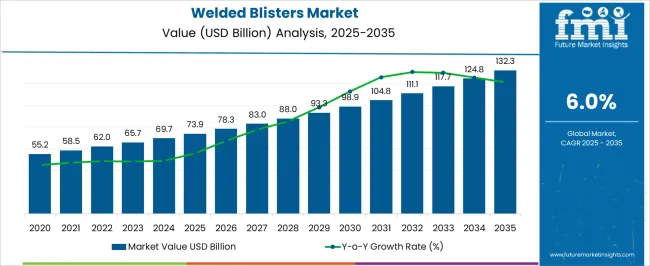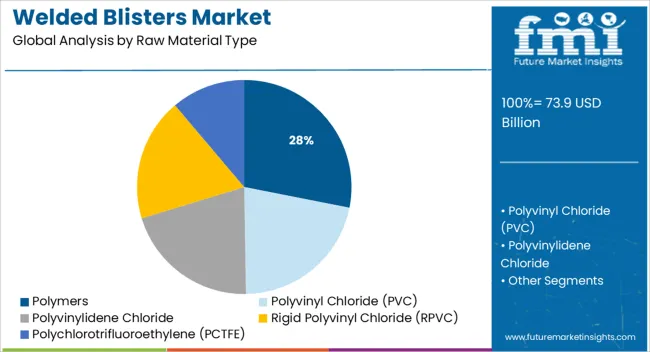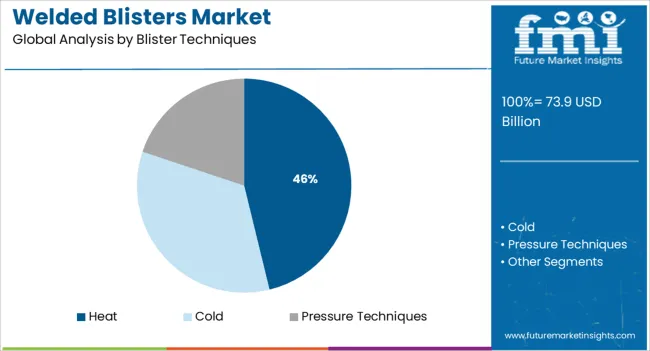The Welded Blisters Market is estimated to be valued at USD 73.9 billion in 2025 and is projected to reach USD 132.3 billion by 2035, registering a compound annual growth rate (CAGR) of 6.0% over the forecast period.

| Metric | Value |
|---|---|
| Welded Blisters Market Estimated Value in (2025 E) | USD 73.9 billion |
| Welded Blisters Market Forecast Value in (2035 F) | USD 132.3 billion |
| Forecast CAGR (2025 to 2035) | 6.0% |
The welded blisters market is experiencing a steady growth trajectory supported by increasing demand for secure and tamper-evident packaging across pharmaceutical, electronics, and consumer goods industries. The shift toward transparent packaging that enhances product visibility while offering high structural integrity is contributing to broader adoption of welded blister formats.
Manufacturers are focusing on recyclable and food-grade materials, and investing in advanced sealing technologies to meet evolving compliance and safety standards. Technological advancements in blister tooling, welding accuracy, and sealing pressure control have improved production efficiency and minimized material waste.
Regulatory focus on anti-counterfeiting and extended shelf-life protection is further reinforcing demand. Future opportunities are expected in biodegradable polymer integration and automated high-speed sealing platforms as industries seek to align packaging operations with sustainability and supply chain resilience strategies.
The market is segmented by Raw Material Type, Blister Techniques, Product Type, and Applications and region. By Raw Material Type, the market is divided into Polymers, Polyvinyl Chloride (PVC), Polyvinylidene Chloride, Rigid Polyvinyl Chloride (RPVC), and Polychlorotrifluoroethylene (PCTFE). In terms of Blister Techniques, the market is classified into Heat, Cold, and Pressure Techniques. Based on Product Type, the market is segmented into High Frequency Welded Blisters, Radio Frequency (RF) Welded Blisters, Ultrasonic Welded Blisters, and Thermowelded Blisters. By Applications, the market is divided into Cosmetics, Pharmaceuticals, Food and Beverages, and Toys and Electronics. Regionally, the market is classified into North America, Latin America, Western Europe, Eastern Europe, Balkan & Baltic Countries, Russia & Belarus, Central Asia, East Asia, South Asia & Pacific, and the Middle East & Africa.

The polymers category is anticipated to contribute 28.1% of the welded blisters market revenue in 2025 within the raw material type segment. This leading share is attributed to the superior flexibility, clarity, and sealing compatibility offered by polymers, particularly in applications requiring visibility and product protection.
Polymers support diverse welding techniques while maintaining structural rigidity and lightweight performance. Their wide adaptability across sectors such as medical, food, and consumer electronics has made them the preferred choice for blister manufacturing.
Additionally, the availability of recyclable and food-safe grades is aligning polymer use with sustainability goals. Manufacturers are also leveraging material innovations to enhance barrier properties, reduce form thickness, and enable better weldability, further consolidating the polymer segment's position in the market.

The heat-based blister technique is expected to dominate with a 46.2% share of total market revenue in 2025. Its prominence stems from its reliability, cost efficiency, and widespread integration in automated packaging lines.
The ability to produce strong and consistent seals through controlled thermal energy has made heat sealing the standard method for blister packaging across mass production settings. It supports high-speed throughput with minimal tool wear and is compatible with a wide range of thermoplastics and laminate structures.
The method’s proven effectiveness in producing tamper-resistant packaging without compromising visibility or shape has driven its adoption in regulated sectors such as pharmaceuticals and consumer healthcare. Continuous upgrades in temperature control systems and pressure distribution have further enhanced seal integrity, reinforcing its dominant share within blister welding techniques.

High frequency welded blisters are projected to account for 29.5% of revenue in 2025 under the product type segment. This leadership is supported by the precision, aesthetics, and strength achieved through radio frequency welding, particularly in packaging formats requiring clear sealing around contoured or irregular shapes.
The technology enables tight, uniform welds that maintain visual clarity and reduce seal failure, which is especially valued in medical device packaging and high-end consumer goods. Its ability to seal thicker materials and multi-layered films has extended its application scope.
Moreover, high frequency welding offers a clean sealing process without adhesives, aligning with safety and hygiene protocols. Continued investment in energy-efficient RF generators and automation-friendly welding units is supporting further growth of this product category in the welded blisters market.
Welded blisters market has emerged as a dynamic development in the packaging market due to the light sensitive nature of welded blisters. Welded blisters protect products from UV rays while providing a longer shelf life to products across various industries. These tamper resistant and durable blisters are contributing to the promotion of welded blister market.
Welded blisters provide compact and precise packaging to maintain product quality by efficiently using the space. Manufacturers of welded blisters have to ensure that the best quality raw material are used for the blister formation, so as to have the transparent exposure of the product. The welded blisters are two thermoformed valves sealed together by a welding machine.
Blister halves are transparent in nature and designed around the product aiding to the complete exposure of the product. This allows brands to publicize the product to the customers by inserting a small piece of cardboard between the two welded blister halves which permits advertising of the product.
The quality of welded blisters in protecting expensive consumer protection against theft and shoplifting is contributing to the growth of the welded blisters market. Another factor promoting the growth of welded blister market is that more than a single product can be packed together allowing large distribution of the product.
Welded blisters are preferred by brands in order to publicize, promote and exhibit the product. The design and technology of welded blisters to use the space around the product through thermoformed blisters protects the integrity of the product. Welded blisters offer protection against moisture and pollution for a longer period of time, which allows the product to have a longer shelf life.
However, the primary factor hindering the growth of welded blisters market is the requirement of a special sealing process for welding the two halves of the blister. Welded blisters market is also facing a barrier due to the fact that the welded blisters can only be cut open with the help of a knife or scissors.
The use of tailor made polyvinyl chloride (PVC) thermoforming in various colored blisters is observed to be an emerging trend in the welded blisters market. Players in the welded blisters market are improving their product offering by adopting to new cold blister technique for creating steeper blister angles using lesser raw material.
Geographically, the welded blisters market can be segmented into five key regions including North America, Asia-Pacific, Europe, Latin America and Middle East and Africa (MEA). North America and Asia-Pacific are the fastest growing manufacturer of the welded blisters market and is anticipated to grow at the same rate. Therefore, due to the new market emergence and the growth in the pharmaceutical sector over the past decade, the welded blisters market in Asia and Europe is also expected to grow at a healthy rate over the forecast period of 2020-2035.
Some of the key players of the welded blisters market are Dispak Industries, BDN Packaging Ltd, Ellepack, PeckpakGDK, Goel Plastic India and Lovell Industries.
The research report presents a comprehensive assessment of the market and contains thoughtful insights, facts, historical data, and statistically supported and industry-validated market data. It also contains projections using a suitable set of assumptions and methodologies. The research report provides analysis and information according to categories such as market segments, geographies, types, technology and applications.
The global welded blisters market is estimated to be valued at USD 73.9 billion in 2025.
The market size for the welded blisters market is projected to reach USD 132.3 billion by 2035.
The welded blisters market is expected to grow at a 6.0% CAGR between 2025 and 2035.
The key product types in welded blisters market are polymers, polyvinyl chloride (pvc), polyvinylidene chloride, rigid polyvinyl chloride (rpvc) and polychlorotrifluoroethylene (pctfe).
In terms of blister techniques, heat segment to command 46.2% share in the welded blisters market in 2025.






Full Research Suite comprises of:
Market outlook & trends analysis
Interviews & case studies
Strategic recommendations
Vendor profiles & capabilities analysis
5-year forecasts
8 regions and 60+ country-level data splits
Market segment data splits
12 months of continuous data updates
DELIVERED AS:
PDF EXCEL ONLINE
Stainless Steel Welded Pipe Market Size and Share Forecast Outlook 2025 to 2035
Key Companies & Market Share in the Stainless Steel Welded Pipe Sector
Electric Resistance Welded (ERW) Pipes and Tubes Market Analysis by Type, Application and Region: Forecast for 2025 to 2035
Helical Submerged Arc Welded (HSAW) Pipes Market Analysis by Outer Diameter, End-Use, and Region through 2035

Thank you!
You will receive an email from our Business Development Manager. Please be sure to check your SPAM/JUNK folder too.
Chat With
MaRIA